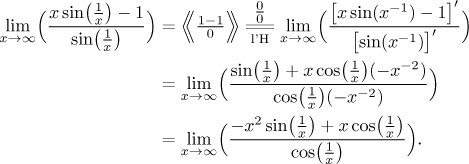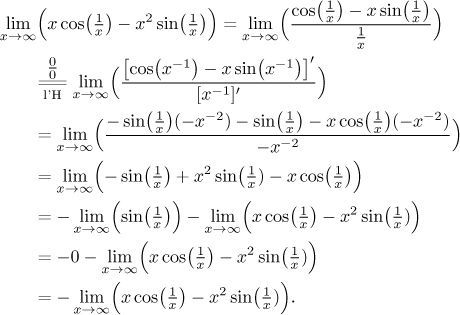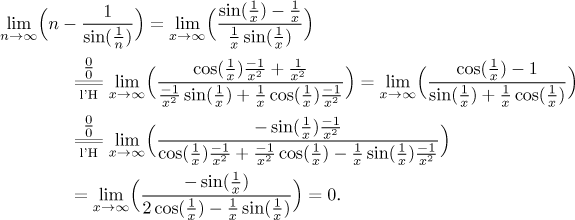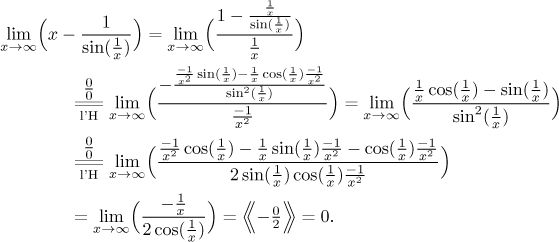Problem: Evaluate the following limit (if it exists)
![]()
Solution:
First we try to put in infinity. Note that for n we put positive
numbers, so
![]()
Recall that 1/0 is an expression whose outcome cannot be decided and must be
investigated closer, which is why we needed to figure out that the zero is
actually 0+. The fact that
Anyway, we did not find the limit, but the attempt told us that this problem belongs to the box indeterminate difference. The standard solution calls for some way to change this into a fraction. We will try to create a common denominator.

We would like to appeal to
Mr. l'Hospital, but unfortunately,
it does not apply to type "something over infinity".
We need to find out what is in the numerator; that is, first we need to find
out the limit of the product
How do we find out what is the limit of

Note how we sometimes write

What is this expression? Substituting infinity yields

We have a problem again. We should first investigate the product of x2 and sine, and just like above (changing it into a fraction, applying l'Hospital) we find that it goes to infinity. Smarter approach would just use the above calculations like this:
In any case, what we got overall is the fracion "infinity minus infinity, that all divided by 1". The division by 1 is no problem, so it is probably best to simply take it out of the expression and evaluate it separately.

We are left with the "infinity minus infinity" part. We are supposed to make it into a fraction and apply l'Hospital, hoping that this time we get something decent. However, now there is no obvious common denominator. What do we do?
One possibility is to use the universal trick for changing difference into a fraction. It leads to terrible things, as you can see here.
A smart student would notice that if one x was taken away from the
expression, there would appear

We see that we obtained an indeterminate product, and there is even an obvious candidate for "putting under". Here we go:

Surprisingly we got the same limit, just with the opposite sign. What does it mean?
First of all, this shows that the method we tried does not help, repeating the l'Hospital trick would just change the sign again. Was there any moment in our calculations where we had another option? None that we would see. This "direct" way therefore cannot tell us more.
The fact that after applying the l'Hospital rule we obtained the same limit,
just with the opposite sign, is strange. Can we use it to get at least some
information? Yes. If there is no limit, we obviously cannot say more. What
happens if this limit does exist and is equal to, say, L? The above
equation then reads L = −L, that is,
Either the given limit does not exist, or it must be equal to zero.
If we want to solve this problem, we need to take a different track right from the start. How about this: Indeterminate differences can be often solved by changing them into products, usually indeterminate. Here we would do it this way:
![]()
The standard procedure for an indeterminate product is to change it into a ratio, which usually leads to l'Hospital's rule. Let's try it.

This looks quite bad, essentially this is another blind alley. What can we
do? The key to success is the observation that in both methods the trouble
is caused by the x that keeps interfering with

The second approach goes like this:

Both is quite dreadful, but it does give us the answer. Nevertheless, once
we get

This is most likely the best solution.